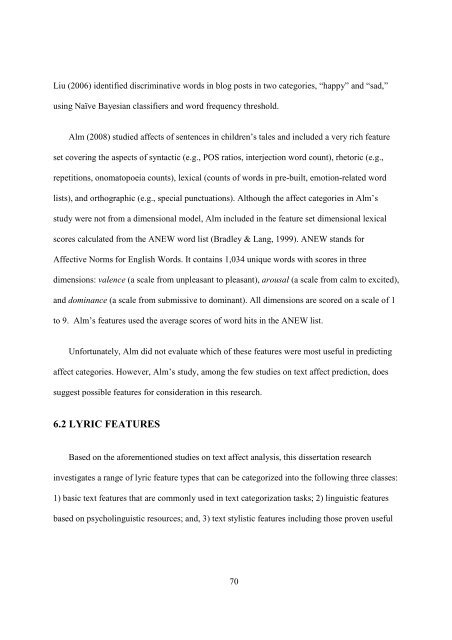improving music mood classification using lyrics, audio and social tags
improving music mood classification using lyrics, audio and social tags
improving music mood classification using lyrics, audio and social tags
Create successful ePaper yourself
Turn your PDF publications into a flip-book with our unique Google optimized e-Paper software.
Liu (2006) identified discriminative words in blog posts in two categories, “happy” <strong>and</strong> “sad,”<br />
<strong>using</strong> Naïve Bayesian classifiers <strong>and</strong> word frequency threshold.<br />
Alm (2008) studied affects of sentences in children’s tales <strong>and</strong> included a very rich feature<br />
set covering the aspects of syntactic (e.g., POS ratios, interjection word count), rhetoric (e.g.,<br />
repetitions, onomatopoeia counts), lexical (counts of words in pre-built, emotion-related word<br />
lists), <strong>and</strong> orthographic (e.g., special punctuations). Although the affect categories in Alm’s<br />
study were not from a dimensional model, Alm included in the feature set dimensional lexical<br />
scores calculated from the ANEW word list (Bradley & Lang, 1999). ANEW st<strong>and</strong>s for<br />
Affective Norms for English Words. It contains 1,034 unique words with scores in three<br />
dimensions: valence (a scale from unpleasant to pleasant), arousal (a scale from calm to excited),<br />
<strong>and</strong> dominance (a scale from submissive to dominant). All dimensions are scored on a scale of 1<br />
to 9. Alm’s features used the average scores of word hits in the ANEW list.<br />
Unfortunately, Alm did not evaluate which of these features were most useful in predicting<br />
affect categories. However, Alm’s study, among the few studies on text affect prediction, does<br />
suggest possible features for consideration in this research.<br />
6.2 LYRIC FEATURES<br />
Based on the aforementioned studies on text affect analysis, this dissertation research<br />
investigates a range of lyric feature types that can be categorized into the following three classes:<br />
1) basic text features that are commonly used in text categorization tasks; 2) linguistic features<br />
based on psycholinguistic resources; <strong>and</strong>, 3) text stylistic features including those proven useful<br />
70
















